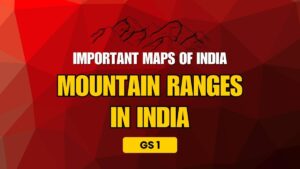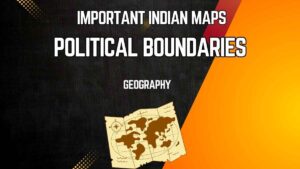Important Indian Maps - Mountain Ranges in India
Table of Contents
Important Mountain Ranges in India
When preparing for UPSC, mapping is crucial. The exam often asks about the location, direction, bordering states, and physiographic role of mountain ranges. These notes will help you both in understanding and in sketching simple maps.
🌄 1. Himalayan Mountain Ranges (Young Fold Mountains)
The Himalayas run west to east along India’s northern boundary (Jammu & Kashmir to Arunachal Pradesh).
Divided into 3 parallel ranges (from south to north):
Shiwaliks (Outer Himalayas) → closest to plains.
Lesser Himalayas (Himachal Range) → famous hill stations.
Greater Himalayas (Himadri) → tallest peaks (Mt. Everest, Kanchenjunga).
Important Sub-Ranges (State-wise):
Jammu & Kashmir / Ladakh
Zanskar Range – north of main Himalayas, separates Zanskar Valley from Ladakh.
Karakoram Range – includes K2 (Godwin Austen, 8611m), India’s highest peak.
Pir Panjal Range – lies to the south of Kashmir Valley, important passes (Banihal).
Himachal Pradesh & Uttarakhand
Dhauladhar Range – near Kangra Valley.
Nag Tibba Range – in Uttarakhand.
Garhwal Himalayas – includes Nanda Devi (7816m).
Sikkim & Arunachal Pradesh
Kanchenjunga Range – world’s 3rd highest peak.
Patkai-Bum, Mishmi & Namcha Barwa Ranges – easternmost Himalayas, link to Myanmar.
📌 Mapping Tip: Always remember → Himalayas arc NW (J&K) to SE (Arunachal), like a bow.
🏞 2. Trans-Himalayan Ranges (North of Himalayas)
Found in Ladakh & Jammu & Kashmir.
Karakoram, Ladakh, Zanskar, Kailash Ranges.
These are cold desert areas with high passes (Khardung La, Zoji La).
📌 UPSC Relevance: Often map-based MCQs on Karakoram Pass, Aksai Chin, Siachen Glacier.
🌄 3. Peninsular Mountain Ranges (Old, Eroded, Block Mountains)
Unlike Himalayas, these are old and rounded. They mostly run east–west or north–south inside the Deccan Plateau.
🌄 Major Peninsular Ranges
Aravalli Range
Oldest fold mountains in the world (Precambrian, over 2.5 billion years old).
Runs SW–NE from Gujarat (near Palanpur, Mt. Abu) through Rajasthan → Haryana → Delhi.
Highest peak: Guru Shikhar (1,722 m, Mt. Abu, Rajasthan).
Important features:
Rich in minerals (copper, zinc, lead).
Delhi Ridge = northernmost extension.
Acts as a climatic barrier, preventing desert expansion eastward.
Vindhya Range
Runs west–east across Madhya Pradesh (dominant) into eastern UP.
Mainly a chain of discontinuous hills & escarpments.
Significance:
Acts as a geographical divide between Northern India (Indo-Gangetic plains) and Southern India (Deccan plateau).
River Narmada flows westward through a rift valley between Vindhyas (north) & Satpuras (south).
Satpura Range
Lies south of Vindhyas, running parallel (west–east).
Spread: Madhya Pradesh → Maharashtra → Chhattisgarh.
Highest peak: Dhupgarh (1,350 m, Pachmarhi Hills, MP).
Significance:
Part of “Central Highlands.”
Rich in forests (Satpura Tiger Reserve, Pachmarhi Biosphere).
Source of rivers like Tapti, Mahanadi tributaries.
Western Ghats (Sahyadris)
Run north–south parallel to India’s west coast (Maharashtra → Goa → Karnataka → Kerala → Tamil Nadu).
More continuous than Eastern Ghats (harder to cross).
Highest peaks:
Anamudi (2,695 m, Kerala — highest peak south of Himalayas).
Dodabetta (2,637 m, Nilgiris, Tamil Nadu).
Significance:
Origin of many rivers: Godavari, Krishna, Kaveri, Periyar.
Western face is a steep escarpment = heavy rainfall (Western Coastal Plains).
UNESCO World Heritage Site → biodiversity hotspot.
Eastern Ghats
Run discontinuously along the east coast (Odisha → AP → TN).
Cut by rivers: Godavari, Krishna, Kaveri.
Highest peak: Jindhagada Peak (1,690 m, Andhra Pradesh).
Significance:
Less continuous → easy for east–west movement.
Rich in minerals (iron, bauxite).
Nilgiri Hills
Junction of Western & Eastern Ghats (Tamil Nadu, Kerala, Karnataka).
Highest peak: Dodabetta (2,637 m).
Famous hill stations: Ooty, Coonoor.
Rich in shola forests & tea plantations.
Cardamom Hills (Kerala)
Southernmost part of Western Ghats.
Known for spice plantations (cardamom, pepper).
Anaimalai Hills (Kerala–TN border)
Anamudi (2,695 m) — highest peak in South India.
Shevaroy Hills (TN)
Located in northern Tamil Nadu, famous for Yercaud Hill Station.
Biligirirangan Hills (Karnataka–TN border)
Ecological bridge between Western & Eastern Ghats.
Mahadeo Hills (MP)
Part of Satpura system, near Pachmarhi.
Rajmahal Hills (Jharkhand)
Volcanic origin, known for fossil-bearing rocks.
Parasnath Hills (Jharkhand)
Important Jain pilgrimage site.
Mikir Hills (Assam)
Near Kaziranga National Park, older than Himalayas.
🏔 4. Coastal & Island Ranges
Shiwalik Extensions (Purvanchal Hills) – Mizoram, Nagaland, Manipur, Tripura (Lushai, Patkai, Naga hills).
Andaman & Nicobar Islands – submerged extension of Arakan Yoma (Myanmar).
🧭 5. Mapping Orientation – Key for UPSC
When practicing maps:
Draw a rough India outline.
Mark Himalayas (arc NW–SE).
Place Aravallis (SW–NE).
Draw Vindhya & Satpura (East–West).
Western & Eastern Ghats (parallel to coasts).
Nilgiris at their junction.
👉 Remember North to South sequence (very common UPSC trick):
Karakoram → Zanskar → Pir Panjal → Shiwaliks.
Aravallis → Vindhyas → Satpuras → Western/Eastern Ghats → Nilgiris → Cardamom Hills.
🔑 Why Important for UPSC?
Prelims: Map-based MCQs (arrangement, state coverage, rivers originating).
Mains: “Discuss the physiographic importance of Indian mountain ranges.”
Interview: Questions like “Why are the Western Ghats biodiversity hotspots?”
-
Important Mountain Ranges in India
When preparing for UPSC, mapping is crucial. The exam often... -
Important Indian Maps – Political Boundaries
Important Indian Maps - Political Boundaries of India comprises of... -
Servants of India Society – Important UPSC Notes
Servants of India Society was founded by Gopal Krishna Gokhale.... -
Sea Level Rise at India’s Coastal Region – Important UPSC Notes
The World Meteorological Organization (WMO) released its State of the... -
Indian Urban Drainage Crisis – Important UPSC Notes
The post "Indian Urban Drainage Crisis" talks about the issue... -
Jayaprakash Narayan Important UPSC Notes
Commemorating the 51st anniversary of Jayaprakash Narayan’s (JP) “Total Revolution”... -
Sant Kabir Das – UPSC Notes
Sant Kabir Das Jayanti was celebrated on June 11, 2025,...








